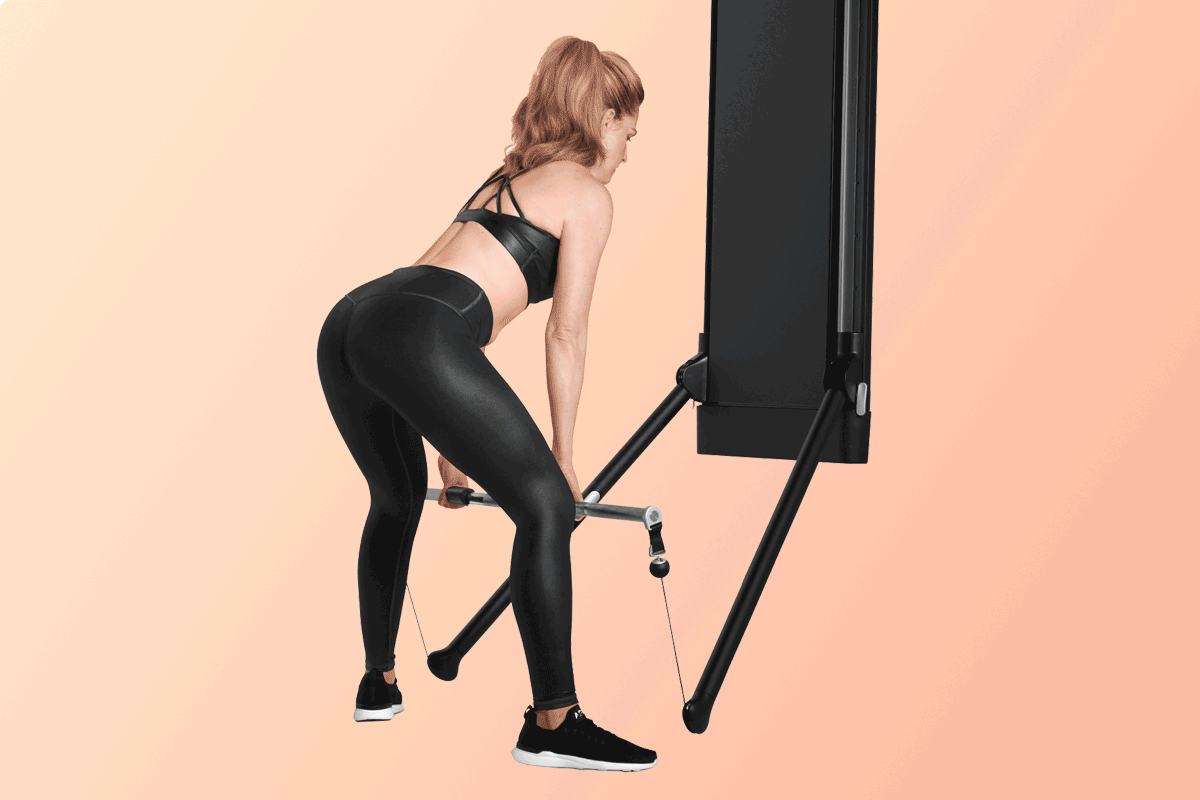Learn what causes this common squat problem and how to fix it.

The squat is a fundamental exercise for building strength in your lower body. It’s ubiquitous in training programs because it works the glutes, quads, and core, and develops power. Although the movement seems simple, nailing the perfect squat form can be tricky. One thing to look out for? A butt wink during your squat. It’s a funny-sounding—but common—mistake. Learning how to prevent it can help you get stronger faster and spare you from a lower back injury.
Here, Tim Landicho, a certified strength and conditioning specialist and Tonal coach, breaks down the biomechanics of a butt wink and how you can avoid it.
What is Butt Wink?
Butt wink occurs when the pelvis tucks underneath your body at the bottom of a squat, causing rounding in the lumbar spine (lower back). Despite the cheeky name, this common mistake is not something you want to see when you’re lifting. Squats should be performed with a neutral spine, not with hips scooped under, as seen in butt wink. Rounding through the spine could potentially lead to back pain. You also won’t be able to lift as much weight without proper form.
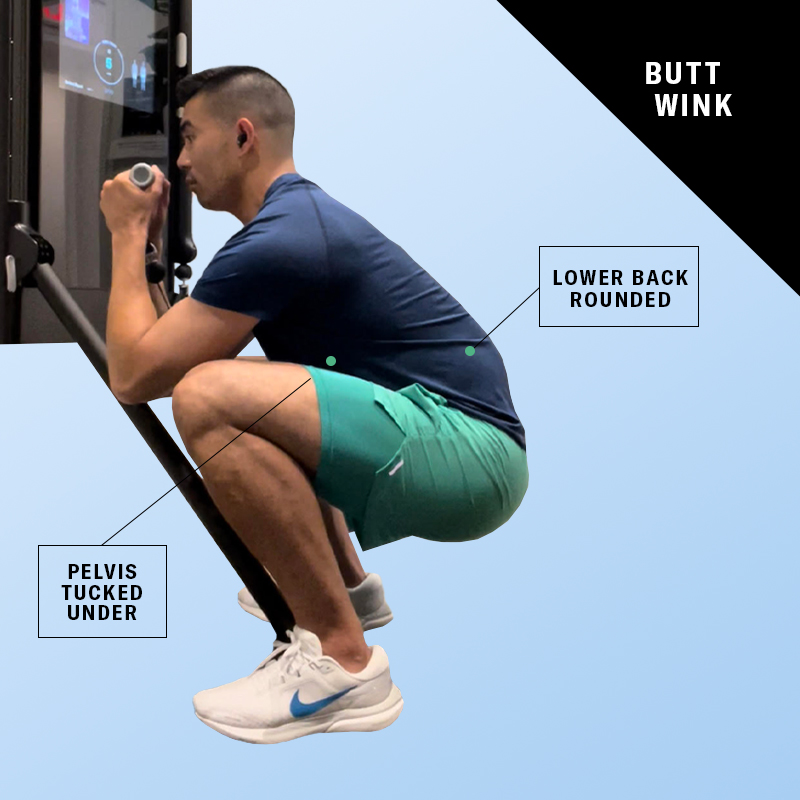
If you’re not sure whether you’re butt winking in your squat, try filming yourself from the side or asking someone to watch your form.
What Causes Butt Wink During a Squat?
According to Landicho, the two most common causes of butt wink are limited mobility (typically in the hips or ankles) and lack of motor control, which causes instability. The latter is more common among beginners who are still learning how to squat properly. Determining which issue is causing your butt wink is the first step to fixing it.
Landicho recommends ruling out a motor control problem first by seeing if your butt wink goes away after practicing proper squatting form. He has a ground-up checklist you can use to make sure your form is correct.

“If you can maintain these sensations all the way through the full range of movement, you can be pretty sure you’re in a good position,” he says.
Starting Position
- Stand with feet hip-width apart and toes pointed forward or out at an angle no more than 30-degrees. You can also try standing with your feet wider. “Playing around with width, in conjunction with turning out of the feet, should go a long way in helping someone get to a more comfortable bottom position,” says Landicho.
- Keep your weight distributed evenly through your feet from heels to toes. Landicho suggests a “tripod foot” position in which you feel your weight balanced between your heel, big toe, and pinky toe.
- Unlock your knees, standing with a soft bend. This allows for stronger engagement of your core and hamstrings.
- Keep your pelvis upright. Think of it as a bowl you’re trying not to spill forward.
- Engage your core by pulling your ribs toward your hip points. Try to mimic the feeling of doing a plank on the floor.
- Keep your head stacked over your body.
Squat Movement
- Send your hips back and bend your knees, tracking over your toes, while keeping feet pressed into the floor, as if you’re sitting into a chair behind you.
- Your knees should track over the second or third toe, not collapse inward toward the big toe.
- Lower your hips as deeply as you can while keeping the ribcage stacked over your pelvis as you did at the start.
- Push through your feet to stand up tall.
If your butt wink is gone after tuning into your form, or if you’re able to get lower in your squat before butt wink appears, you’re likely dealing with a motor control issue and need to become more familiar with the movement.
If your form is solid, but you’re still butt winking, you probably have limited mobility in your ankles or hips. Here’s how to figure out which joints are hindering your movement.
Ankle Dorsiflexion Test
- Get into a half-kneeling position with your front foot directly under your knee and your toes about a hand’s-width away from a wall.
- Bend your front knee forward, trying to touch it to the wall while keeping your entire foot on the ground.
- If you’re unable to touch your knee to the wall, you likely have limited ankle mobility.
Hip Flexion Test
- Lie on your back with one leg flat on the floor and one knee bent.
- Bring your bent knee to your chest while keeping your other leg on the floor.
- If you can’t move your knee closer than a 90-degree angle with your hip, your hip mobility is likely limited.
How to Fix Butt Wink to Improve Your Squat
Working to improve your range of motion will help get rid of butt wink in your squat if you’re dealing with a mobility issue. Instead of static stretching, Landicho recommends active movements for building range of motion because they also create stability in the muscles around the joints.
“A stretch by itself can create some temporary change, but what’s going to create more lasting change is actually stressing the tissues through a contraction in the fullest range of motion possible,” he says.
Here are two exercises that will help you gain mobility in your ankles and hips:
For Ankle Dorsiflexion: Elevated Full Range of Motion Calf Raise
- Stand on a step or box with the ball of your foot on the edge and your heel hanging off.
- Raise up on the ball of your foot into a calf raise.
- Lower your heel as much as possible at the bottom of the movement. Emphasize the stretch at the bottom as this brings your ankle into dorsiflexion.
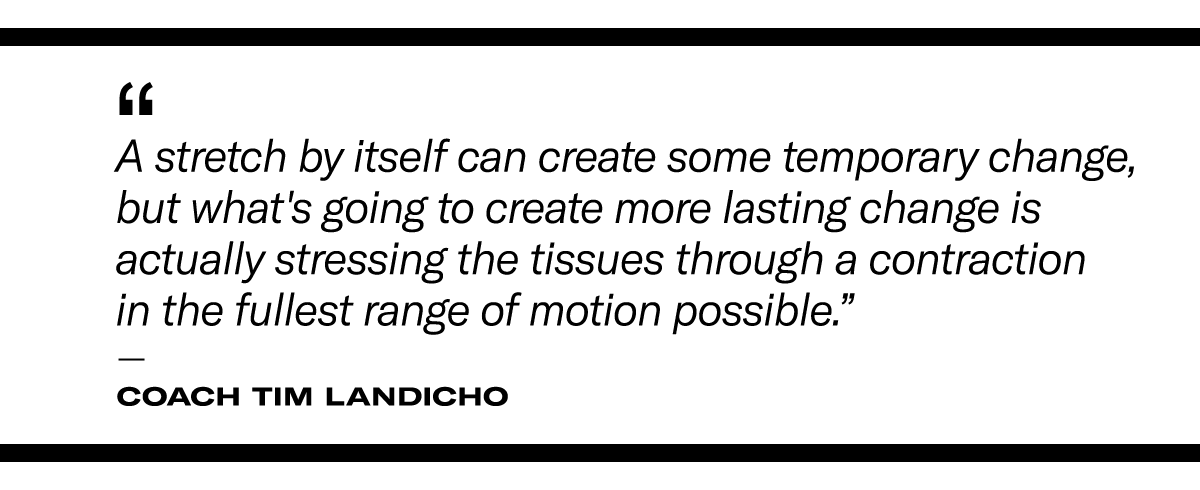
For Hip Flexion: Quadruped Rocking
- Start on all fours with your knees under your hips and your hands under your shoulders.
- While maintaining a neutral spine, practice rocking your hips back and forth to access your full range of motion.
- This movement mimics how you move when you’re standing upright and squatting.
- Use your arms to assist you by pushing your hands against the floor.
- For even more core engagement, try the move with your knees hovering above the floor.
On Tonal, try adding Ankle Fitness for Mobility with Coach Nicolette Amarillas or Hip Mobility Clinic with Coach Liz Letchford to your routine. Both workouts include a series of exercises designed to build up your range of motion in these joints.
For Motor Control: Core Drills and Squat Progression
Because keeping a strong core is crucial in maintaining proper squat form, Landicho suggests doing these moves as drills to prep for your squats. “Play with these to bring sensory awareness to proper engagement throughout the day or immediately before the workout or squat progression,” he says.
Pillar Bridge

Why it Works: This movement strengthens the abdominal muscles that are important for stability in a squat. When done correctly, you’ll feel the same sensation of a stacked torso (ribcage over pelvis) that you should also have at the start of your squat.
How to Do it: Get onto your mat facing the floor with both elbows under your shoulders and feet hip distance apart, toes tucked. Lift the knees to extend the legs and push the floor away from you through your elbows.
Dead Bug
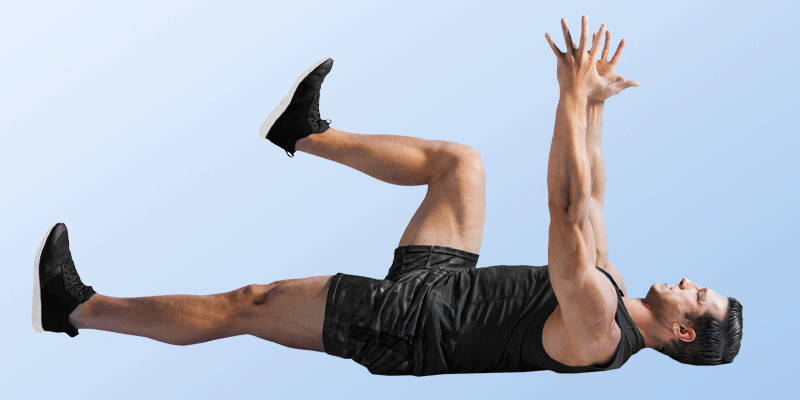
Why it Works: Landicho likes this move because you’ll know right away if you’ve lost proper form in your torso if your back arches off the floor when you extend your limbs. “The floor gives you feedback as to whether you are actually stacked,” he says. “Now you have some sensory awareness of this.”
How to Do it: Lie face-up on your mat and bring your arms extended over your chest, with knees bent over your hips in a tabletop position. Extend one arm and the opposite leg toward the floor. Once your limbs are just above the floor, return to the start without letting your back lift off the ground. Switch sides and repeat.
Next, Landicho recommends moving through this progression of squat variations. These increasingly difficult moves will help you become more familiar with the squat form and encourage the neuromuscular connections that will make it easier to achieve perfect form with every repetition.
Assisted Squat

Why it Works: When you’re working on form, Landicho recommends performing this move as an isometric exercise. Lower down as far as you can before you lose your neutral spine and start the butt wink, and then hold that position.
“Get strong in that range of motion,” says Landicho, “As your nervous system and your other tissues acclimate to that, you will start to be able to more easily access the deeper ranges of motion in a better position.”
How to Do it: With arms straight, grip each side of Tonal. Send your hips back and bend knees like you’re sitting into a chair behind you. Press the floor away from you and squeeze the glutes to stand tall.
Iso Squat Hold

Why it Works: Like the assisted squat hold, this movement strengthens the muscles you need to squat efficiently. Since you’re no longer holding onto a stable surface, you’re also forcing your core to engage to keep you upright.
How to Do it: Stand with your feet shoulder-width apart. Send hips back and bend your knees like you’re sitting into a chair, until your thighs parallel to the floor. Build up to being able to hold this position for 15-20 seconds.
Goblet Squat to Bench

Why it Works: Finding the end range of motion in your squat can be difficult, especially for beginners. For a safe way to practice, Landicho recommends starting with a bench behind you to make sure you’re actually moving like you’re sitting on a chair. Keep your muscles engaged throughout the movement by avoiding the temptation of sitting on the bench: “Do a little touch-and-go instead of resting and losing the tension,” says Landicho
How to Do it: Hold the handle strap with your thumbs wrapped around the top and place it in front of your chest. Stand over the end of the Tonal arm with feet hip-width apart. Turn the weight on. Send your hips back and bend your knees, as if someone is pulling you from behind, then tap your glutes on the bench. Stand by squeezing your glutes and pushing the floor away from you.
Goblet Squat
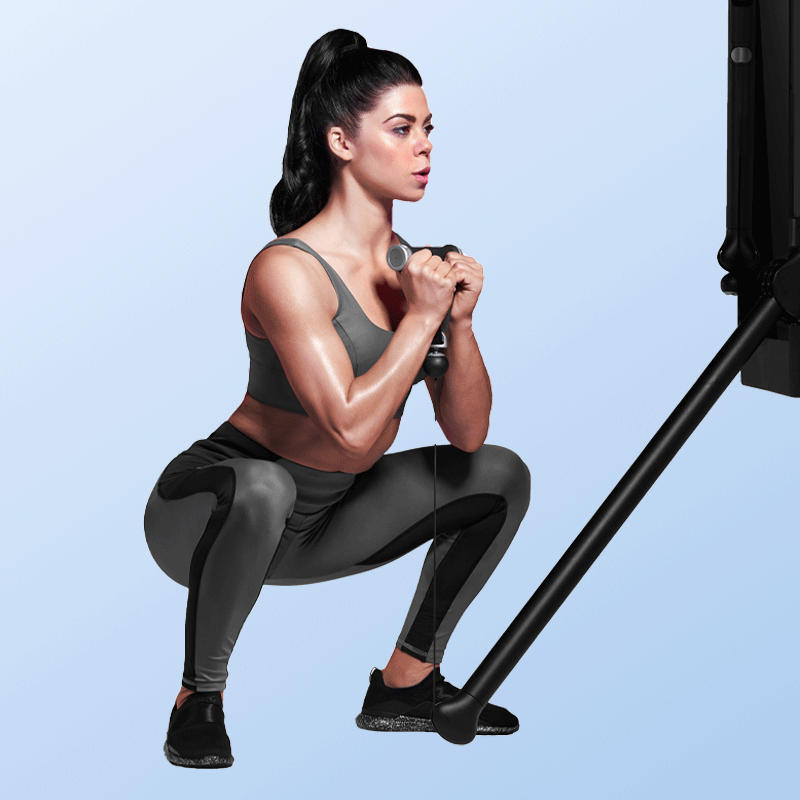
Why it Works: Finally, you’ll be ready to do a weighted squat without the depth feedback you were getting from the bench. When you’re building up to good squatting form, Landicho suggests pulsing at the lowest part of this movement to feel what it’s like to be in control at the bottom of a deep squat. You can also try this move with Eccentric Mode on Tonal to slow down the lowering portion of the squat and focus on maintaining good form.
How to Do it: Hold the handle strap with your thumbs wrapped around the top and position it in front of your chest. Stand with feet shoulder-width apart and toes slightly turned out. Turn the weight on. Send your hips back and bend knees like you’re sitting into a chair behind you. Push the floor away from you and stand tall, powering the hips toward Tonal.
Additional reporting by Lindsay Berra


